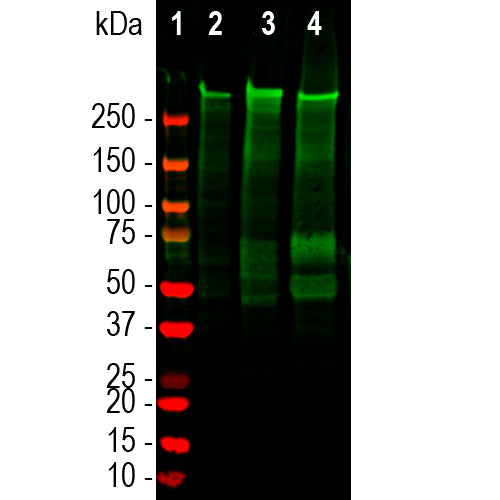


EnCor Biotechnology
Rabbit Polyclonal Antibody to Microtubule Associated Protein MAP2ABCD (MAP2), Cat# RPCA-MAP2ABCD
Description
The RPCA-MAP2ABCD antibody was made against a mixture of recombinant human projection domain sequences and the core MAP2C/D sequence so the antibody binds all isoforms of MAP2. It therefore binds to the high molecular weight MAP2A and MAP2B isoforms and also the lower molecular weight MAP2C and MAP2D forms which lack the projection domain sequences. This antibody is of very high titre, working well at dilutions of 1:10,000. EnCor also markets a mouse monoclonal antibody specific for sequence found in all MAP2 isoforms, MCA-2C4, and also monoclonal antibodies binding epitopes only in MAP2A/B MCA-4H5 and MCA-5H11. We also market chicken and goat polyclonal antibodies to MAP2A/B, CPCA-MAP2 and GPCA-MAP2.
- Cell Structure Marker
- Cell Type Marker
- Cytoskeletal Marker
- Developmental Marker
- Immunohistochemistry Verified
- New Antibodies
- Pathology Related Marker
- Rabbit Polyclonal Antibodies
Add a short description for this tabbed section
| Immunogen: | Mix of recombinant human projection domain sequences, amino acids 377-1505, EnCor products Prot-r-MAP2-P1, Prot-r-MAP2-P2, Prot-r-MAP2-P3 and 4 repeat low molecular weight MAP2 isoform Prot-r-MAP2D |
| HGNC Name: | MAP2 |
| UniProt: | P11137 |
| Molecular Weight: | 280kDa by SDS-PAGE |
| Host: | Rabbit |
| Species Cross-Reactivity: | Human, Rat, Mouse, Cow |
| RRID: | AB_2889161 |
| Format: | Serum plus 5mM NaN3 |
| Applications: | WB, IF/ICC, IHC |
| Recommended Dilutions: | WB: 1:2,000. IF/ICC 1:5,000. IHC: 1:4,000. |
| Storage: | Store at 4°C for short term, for longer term store at -20°C. Stable for 12 months from date of receipt. |
Microtubules are 25nm diameter protein rods found in eukaryotic cells and are associated with a family of proteins called microtubule associated proteins (MAPs). MAPs play a crucial role in the regulation of microtubule dynamics and interactions in vivo. MAP2 was originally named as one of the higher molecular weight MAPs with an SDS-PAGE molecular weight of about 280kDa (1-3). There is a single mammalian MAP2 gene which may generates two high molecular weight proteins of ~280kDa named MAP2A and MAP2B and multiple lower molecular weight forms usually named MAP2C and MAP2D which run on SDS-PAGE gels at 60-70kDa. The lower molecular weight forms are found in neurons early in development, but later are replaced by the higher molecular weight forms (2). The MAP2A and MAP2B forms include a protein insert missing in MAP2C and MAP2D which forms fine filamentous protrusions from the sides of brain microtubules referred to as the "projection domain". This antibody was made against the projection domain sequences and so is specific for MAP2A and MAP2B. MAP2 isoforms are expressed only in neuronal perikarya and dendrites so appropriate antibodies are used to identify these structures in cell culture and sections (for example images in references 4-8 used EnCor MAP2 antibodies).

Chromogenic Immunostaining of a 4% paraformaldehyde fixed paraffin embedded rat cerebellum section with rabbit pAb to MAP2ABCD, RPCA- MAP2ABCD, dilution 1:4,000. Staining was detected with DAB (brown) using Vector Labs ImmPRESS method and reagents with citrate buffer retrieval. Hematoxylin (blue) was used as the counterstain. RPCA-MAP2ABCD strongly labels Purkinje cell perikarya and dendrites in the molecular layer and also granule cells in the granular layer. This antibody performs well with both 4% PFA and standard NBF fixed rat, mouse and human tissues. Mouse select image for larger view.
1. Dehmelt H, Halpain S. The MAP2/Tau family of microtubule-associated proteins.
Genome Biol. 6:204 (2005).
2. Nunez J. Immature and mature variants of MAP2 and tau proteins and neuronal plasticity. Trends Neurosci. 11:477-9 (1998).
3. Vallee R. A taxol-dependent procedure for the isolation of microtubules and microtubule-associated proteins (MAPs). J. Cell Biol. 92:435-42 (1992).
4. Goetz AK, et al. Temporally restricted substrate interactions direct fate and specification of neural precursors derived from embryonic stem cells. PNAS 103:11063-8 (2006).
5. Walton NM et al. Gliotypic neural stem cells transiently adopt tumorigenic properties during normal differentiation. Stem Cells 27:280-9 (2009).
6. Gasser A, et al. An ankyrinG-binding motif is necessary and sufficient for targeting Nav1.6 sodium channels to axon initial segments and nodes of Ranvier. J. Neurosci. 32:7232-43 (2012).
7. Rush AM, et al. Differential modulation of sodium channel Nav1.6 by two members of the fibroblast growth factor homologous factor 2 subfamily. Eur. J. Neurosci. 23:2551-62 (2006).
8. Eckenstein FP, McGovern T, Kern D, Deignan J. Neuronal vulnerability in transgenic mice expressing an inducible dominant-negative FGF receptor. Exp. Neurol. 198:338-49 (2006).
Add a short description for this tabbed section





